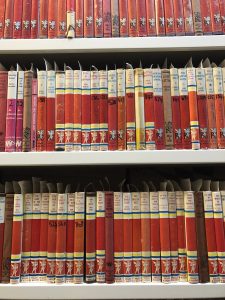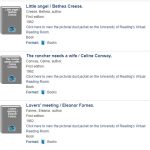Cataloguing the Mills and Boon Book Collection
How we catalogued 4,000 books at once

The Mills and Boon Book Collection at the University of Reading is a collection of over 4,000 books from the Mills and Boon back catalogue, published between 1909 and 2011. Now, as well as being able to browse digital images of the dust jackets on the Virtual Reading Room, researchers can search the full collection via the online catalogue.
What is the Mills and Boon Book Collection?
Here at the University of Reading Special Collections, we are well-known for our collections relating to the British book industry. We hold the archives of several significant publishers, from the Hogarth Press to Ladybird Books. One of these publishing collections is the archive and library of romance publishers, Mills and Boon.
In 2011, Harlequin (the parent company) offered us the Mills and Boon publishing archive along with more than 4,000 books from their back catalogue. The archive includes correspondence between the publishers (John Boon and Alan Boon) and their authors; publicity material; script registers, and other administrative documentation. One curious item from the Mills and Boon Archive is the ‘Boon’s Mots scrapbook of gaffes’, a selection of clippings gathered by the publishers of some of their favourite lines from the books. You can read the BBC News story about the notebook and see digital images of the notebook on the archives database.
Returning to the Mills and Boon Book Collection, publishers sometimes keep what is called a file set of their output: one or more copies of each of their published books. With such a prolific publisher as Mills and Boon – who today publish more than 700 titles every year – a complete file set would probably have tens of thousands of books. So, while our extensive collection of Mills and Boon books doesn’t cover every book they ever published, it does have around 4,300 books published over 102 years, making it one of the most comprehensive collections available.

What makes the Mills and Boon Collection special?
Besides its impressive size and scope, this collection is particularly exciting for having so many intact dust jackets. Some other British libraries have collected Mills and Boon books as a matter of course – copyright libraries are expected to hold a copy of every book printed in the UK – but didn’t necessarily keep the dust jackets. The British Library, for instance, once had a policy of removing dust jackets from books, a rule that was in place from the 1920s into the 1950s.
Knowing how unusual it was to have these dust jackets, in 2018 we ran a digitisation project to get as many of these covers captured as possible. Since, then, we’ve been able to make many of these covers available to browse on the University of Reading Virtual Reading Room, as you can see here: https://vrr.reading.ac.uk/browse/Special_Collections_Library/Mills_and_Boon

We love the dramatic, characterful and colourful dust jackets of the Mills and Boon books – and make the most of them on our Twitter and Instagram accounts. You can see a selection of them on the #MillsandBoonMonday hashtag on social media.
The Mills and Boon Book Collection is also particularly remarkable to us at the University of Reading Special Collections for another, more serendipitous and personal reason. The very first Mills and Boon author was Sophie Cole, a romance author and one of the publisher’s most successful authors in its early days. We are fortunate to have the very first copy of Arrows from the Dark, which was Sophie Cole’s first book, and also the first book Mills and Boon ever published (and this was before they specialised in romantic fiction). Sophie Cole was the sister of Professor Francis J. Cole, the University of Reading zoology academic and collector of the magnificent Cole Library here at Special Collections.
Thousands of books, thousands of dust jackets, and a family link from one of our largest book collections to another (the Cole Library has over 8,000 volumes!): a very special collection indeed!
What challenges were involved in the collection?
As is often the case, the biggest advantage of this collection for researchers is the same as the biggest challenge it poses for librarians: namely, that there’s more than 4,000 books. The question is, where do you start?
The first Mills and Boon Book Collection project was a long-term undertaking – led by volunteers – to list the collection. This listing project took many, many hours of generously donated time from our volunteers. This involved looking at each book, one-by-one, and recording key bits of information: its title, the author, the year it was published, which edition it is, and so on. Listing is an extremely important part of looking after a collection of this size. Without a list, Library staff don’t know what’s in the collection and can’t respond to researcher enquiries accurately. The only option is to go to the shelves and see what you can find, but with thousands of books to go through, that can be too much of a challenge.
However, as valuable as listing is, it isn’t the same as cataloguing. Listing gives fundamental information about each book, in a non-standardised format, such as a written list in a document, or a spreadsheet. Once there is a complete list, the Library and Reading Room staff have a resource to refer to, and can easily see what is in the collection and can respond to questions.

Cataloguing aims to give a full, accurate description of each book, written using a set paradigm of rules and internationally-recognised standards. Once one of our collections is fully catalogued, researchers can discover the books on the catalogue: whether they’re searching on Enterprise, the University of Reading’s online catalogue, or if they’re using a union catalogue such as Jisc Library Hub Discover, which shows where copies of books can be found in research libraries across the country.
Cataloguing is a vital step in making our collections more discoverable and accessible. Once the listing of the Mills and Boon Book Collection had been completed, we started cataloguing the books – one by one – in 2020. However, the process of full-level cataloguing is time-consuming, so this was to be another long-term project: something to chip away at every now and again.
We have lots of projects like this, and it works. However, as our volunteers had made such a thorough list, and we’d heard some stories about importing aggregated data into library management systems, we decided to explore another option as well.
How can you catalogue 4,000 books at once?
Here at Special Collections, we are lucky to have strong ties with the team at the Main Library for the University of Reading. Their team is much larger than ours, with specialist departments for each aspect of librarianship. We approached our colleagues in the Cataloguing team at the Main Library to find out if we could find another way of using the volunteer-made listing to bring the collection onto Enterprise, our shared online catalogue.
We were optimistic that, together, we could change the spreadsheet into something that our library management system could ‘read’ to create catalogue records for each of the 4,000 Mills and Boon books. There was a lot of work to do first. Library catalogue records obey strict rules, somewhere between grammar and punctuation and computer coding language. We had to manipulate the data from the spreadsheet, column by column, to fit the needs of each field of a catalogue record.
By spending time working with the data, we were able to think about what we wanted the catalogue records to show and explore ways of doing that. We wanted to link the record for each book on the catalogue to the corresponding image of the dust jacket on the Virtual Reading Room, and with the help of the Metadata Manager at the Main Library, we found a way to achieve this.

After several months of thinking about the collection, and trying new ways of manipulating the data in different spreadsheets, and with enormous amounts of patience and generous support from the Metadata Manager at the Main Library, the upload is complete, and we have all 4,297 Mills and Boon titles on the catalogue, discoverable for researchers.
This was a completely new way of working for us at Special Collections, and we are excited to have set a new precedent. A great deal of work went into this project – and a lot of abstract thinking about metadata and catalogues – but not nearly as many hours as would have been needed to catalogue each book individually. As well as being thrilled that we can share the full extent of the Mills and Boon Book Collection, we are also excited by the possibilities this way of working could open up to us for future projects – watch this space!
The final result
Now that the collection is fully discoverable, you can search for Mills and Boon books on our online catalogue and for the dust jackets in the Virtual Reading Room. If you find something you want to see in person, you can email specialcollections@reading.ac.uk to arrange a visit to our Reading Room.